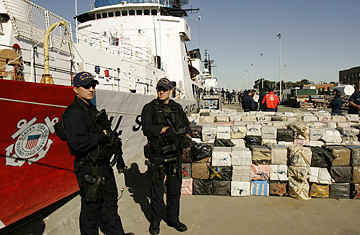
Members of the US Coast Guard stand near packages of cocaine, confiscated off the coast of Panama, in Alameda.
It's a war without a clear enemy. Anything waged against a shapeless, intangible noun can never truly be won — President Clinton's drug czar Gen. Barry McCaffrey said as much in 1996. And yet, within the past 40 years, the U.S. government has spent over $2.5 trillion dollars fighting the War on Drugs. Despite the ad campaigns, increased incarceration rates and a crackdown on smuggling, the number of illicit drug users in America has risen over the years and now sits at 19.9 million Americans. And a large portion of their supply makes its way into the country through Mexico.
The U.S. International Narcotics Control Strategy reports that 90% of cocaine, for example, reaches the United States through its southern border. Drug-related violence in Mexico has gotten so bad that it is now spilling over into states such as Arizona, which has suffered a rash of kidnappings and ransoms. (Arizona's 370-mile border with Mexico serves as the gateway for nearly half of all smuggled marijuana.) Texas' request for National Guard protection from Mexican drug crime prompted Director of National Intelligence Dennis Blair to declare last week that the Mexican government had lost control of its own territory. President Felipe Calderón responded by pointing out that his nation shared a border with "the biggest consumer of drugs in the world and the largest supplier of weapons in the world." In an attempt to partly smooth over any feathers ruffled by the Blair-Calderón spat, Secretary of State Hillary Clinton will travel to Mexico on Mar. 25 and 26. (See pictures of Mexico's drug wars.)
Although the U.S. government has battled drugs for decades — President Eisenhower assembled a 5-member Cabinet committee to "stamp out narcotic addiction" in 1954 — the term "War on Drugs" was not widely used until President Nixon created the Drug Enforcement Administration (DEA) in 1973 to announce "an all-out global war on the drug menace." While reports of widespread heroin use among soldiers in Vietnam sparked an intense outcry, but by 1975 attention had turned to Colombia's cocaine industry. When Colombian authorities seized 600 kilos of cocaine hidden in everything from shoeboxes to a dog cage containing a live dog, drug traffickers retaliated by killing 40 people in one weekend. Nicknamed the "Medellin Massacre" after the city at the center of Colombia's drug trade, the murders ignited years of raids, kidnappings, and assassinations (a 1985 Medellin cartel "hit list" even included names of U.S. businessmen, embassy members and journalists).
During a 1984 appearance at an Oakland, Calif. school, then-First Lady Nancy Reagan was asked by 10-year-old Angel Wiltz what to do if someone offered her drugs. "Just say no," replied Reagan. Within a year, 5,000 "Just Say No" clubs had formed around the country, with Soleli Moon Frye, (Punky Brewster) as honorary chairperson. The Los Angeles Police Department's 1983 Drug Abuse Resistance Education (D.A.R.E.) school lecture program, grew into a national phenomenon that, by 2003, cost $230 million and involved 50,000 police officers. Partnership for a Drug-Free America launched a similarly memorable campaign in 1987 with an abrasive television ad featuring a hot skillet, a raw egg, and the phrase, "This is your brain on drugs."
Catchy slogans are no match for chemical addictions, however, and study after study showed that programs such as D.A.R.E. — no matter how beloved — produced negligent results. And while the Bush administration's 2002 goal of reducing all illegal drug use by 25% led to unprecedented numbers of marijuana-related arrests, pot use only declined 6% (and the use of other drugs actually increased). Drug trends tend to wax and wane, and a dip in the use of one type of drug might lead to a rise in another, causing officials to play a never ending game of narcotic whack-a-mole.
As far as Mexican attempts to halt trafficking, a newly elected President Felipe Calderón declared open season on drug cartels just days after being sworn into office in 2006 when he sent 6,500 troops to quash a rash of execution-style killings between two rival drug gangs. The following year, Calderón's public security minister Genaro Garcia Luna removed 284 federal police commissioners — all suspected of corruption — and replaced them with a hand-selected group of officers who successfully arrested several drug kingpins. The gangs have responded with what seems to be an endless stream of violence; 5,300 people were killed in drug-related crimes in 2008 and over 1,000 have already died this year. (Read "Mexico's Cocaine Capital.")
In 2008, President Bush signed the Mérida Initiative, which would provide $1.4 billion to Mexico and other countries over three years to help combat drug smuggling and violence. So far, only $456 million has been approved and President Obama has not yet said whether he plans to follow through on the remaining billion dollars. But money or no money, the drugs keep coming, and they keep coming fast.
